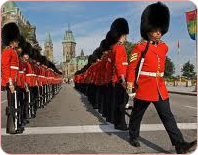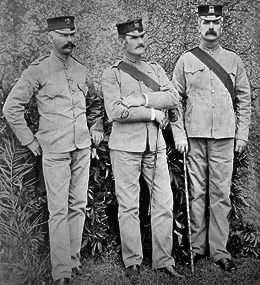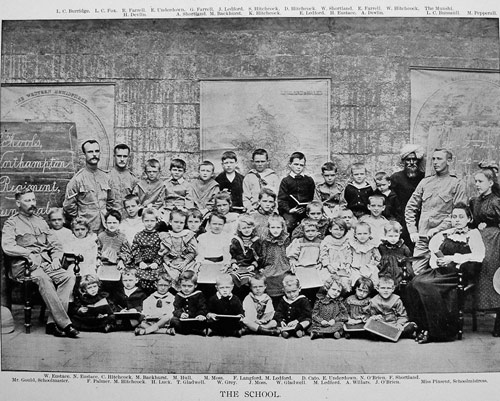
Corps of Army Schoolmasters
A dramatic change occurred in the Royal Military Asylum in 1846. The records are accurate and conclusions drawn from them are open to many interpretations. With this reservation, circumstantial evidence is that preparations for impending change began with the closure of the Southampton establishment and exclusion of girls from further entry to the institution. At the same time, places for the sons of soldiers were restricted to reduce the population by the mid-1840s to make space available for converting the Asylum to an education training establishment or what is commonly known as a ‘Normal School’.
| Population | 1836 | 1837 | 1838 | 1839 | 1840 | 1841 | 1842 | 1843 | 1844 | 1845 | 1846 |
| Females | 76 | 67 | 60 | 56 | 51 | 34 | 29 | 21 | 6 | 5 | - |
| Males | 281 | 279 | 311 | 315 | 338 | 342 | 343 | 339 | 341 | 329 | 329 |
| Total | 357 | 346 | 371 | 371 | 389 | 376 | 372 | 360 | 347 | 334 | 329 |
Table showing the reduction of female entrants to the Asylum reduced between 1836 and 1846
When the RMA opened in 1803 the monitorial system of teaching first introduced by Joseph Lancaster (1778-1838), a member of the Society of Friends. Lancaster wrote a convincing paper on monitorial teaching which gained him an audience with George III. Impressed, the King persuaded his son, the Duke of York to become a member of Lancaster's monitorial committee. It is no surprise therefore that Lancaster's system of reaching was used in the new Asylum when it opened in1803. Under the system, a teacher first taught a group of monitors – up to ten – the lesson to be taught. They in turn instructed as many children again what they had been taught.
Within five years, Dr Andrew Bell, an Anglican clergyman who had developed a similar system for use in an orphanage in Madras, India, known as the Madras System, replaced Bell. He had a distinct advantage over Lancaster in that he was an Anglican and there was no more powerful a force in the country than the Established Church had no difficulty transferring their allegiance. They were fierce defenders of the established order. In the absence of a more sophisticated method of teaching, the monitorial system was wildly successful and young monitors from the Asylum were sent to military units throughout home and foreign stations, to Lisbon (during the Napoleonic Wars), Canada, Australia, India, Malta and possessions in the Caribbean and elsewhere.
The winds of change began blowing from the time the last girls departed in 1845. The power behind those winds appears to have been Fox Maule Ramsay, a former military officer who became a member of parliament in 1935. He was secretary-at-war from 1846 to 1852 and the prime mover who brought about the changes that led to the creation of the Corps of Army Schoolmasters.
Two scholars were engaged to run the Ecole Normale for training teachers and a model school at which the teachers in training could put the methods taught to the test. Dr Walter McLeod, a graduate of the University of Glasgow and Fellow of the Royal Geographical Society had previously been headmaster of the Battersea Training School for Teachers. He was a strong advocate of the methods of Pestalozzi, an internationally recognized authority on education, and had written a number of books including Exercises in Arithmetic for Elementary Schools. McLeod became headmaster of the model school and worked closely with du Sautoy.
Dr du Sautoy (St. John's College, Cambridge) was first a scholar and, as well, an ordained minister. He was engaged to replace the incumbent chaplain and headmaster of the Asylum for over forty years, the Rev. George Clarke. Between them, du Sautoy and Mcleod developed a lengthy programme of training for army schoolmasters.
A selection board screened volunteers wishing to become army schoolteachers. The course took a year and, after graduation, if student teachers stayed the course, they were required to enlist and teach at whatever military unit to which they were posted. Postings could be in the Home Command (which by 1847 included Irish Command) or with an overseas station.
The screening process was not at first the success the military authorities might have wished. Of the first 29 students engaged to take the training course, ten were dismissed and one was publicly expelled; three left (by absconding), one was withdrawn and another student teach was recommended to withdraw. That is, of the original 29, less than half (fourteen) graduated, enlisted and were posted to units not a good batting average.
The standard of acceptance for those taking the course was low. The examination could be taken at a centre outside London, so the chances of someone having the paper written for them was a distinct possibility going by some of the notations entered in the register. The register contained a record of each student's knowledge of reading, scripture, English history, ancient history, geography, arithmetic, geometry and algebra.
Typical of the early subjective entries of what a student knew on entering the programme are the following:
Reading – Fair, reads with a Scotch accent
Scripture – Good
English history – Fair
Ancient history – Knows nothing
Geography – Poor
Arithmetic – Poor
Geometry – Nil
Algebra – Nil
Not one in twenty candidates accepted had any knowledge of geometry or algebra; few knew anything of ancient history or English history. The general knowledge of geography was also poor. Reading had fair to good notations and those for scripture ranged from fair to good. Reports were sent regularly to the office of the secretary-at-war. Some candidates could not, or would not, find anyone willing to sign the bond required upon graduation. This was a problem because of the cost of training. It was solved in time by an improved selection process and a signed undertaken obtained from those in training that they would have their bonds signed and would enlist for military service.
Despite the problems of teaching, bonding graduates and enlisting them for military service, the programme became increasingly successful. The authorities soon leaned how to choose candidates for training and, gradually, the available positions for a schoolmaster in every battalion, squadron or battery were filled.
The Elementary Education Act of 1870 was the first nationally financed education system. The British Army made its first foray into education with the monitorial system of Lancaster and Bell at the beginning of the 19th Century. With the creation of its Ecole Normale and model school in 1846, the Army pioneered teacher training methods long before the idea occurred to civil government to enact a Elementary Education Act. The public schools (private schools in the U. S. A.) had long since developed education curricula, but nothing had been attempted on a national scale for the bulk of the civilian population. It should therefore be no surprise that, following enactment of the Act, teachers should be in high demand.
Once those trained by the army had completed their military service they were assured of employment in the national elementary schools.
It might be thought that schoolmasters in the British Army enjoyed a privileged position. They were members of the Sergeant's mess, but had no military duties outside their responsibilities for managing the regimental school. Even so, the more vociferous among them found much to complain about. Between 1850 and 1900, more than 80 letters were published in The Times from schoolteachers with a beef.

Writing to The Times in July 1861, a correspondent wished to bring to the world's attention an injustice inflicted on army schoolmasters, which he described as 200 'zealous, though humble, servants of the crown and country. In passing, humble would be the last adjective to describe anyone employed in the education industry at any time in the history of the occupation. The correspondent wrote to complain that the military authorities were to cancel the Royal warrant issued under Army School Regulations (c1852), which would ‘reduce army schoolmasters to the position of staff-sergeants, and to treat them as sergeants in every respect.’ He regarded the cancellation of the warrant as an "...anti-progressive movement to dishonour the instructor...’ that would place ‘educated men’ in an invidious position, which would be an indignity to them.
We know from the records that the 200 schoolmasters to whom the correspondent referred were far from 'educated gentlemen' by any standards when each embarked on a one to two-year course of instruction at the Army's expense. They had received the equivalent of a college education in return for ten years of military service; not much different from contemporary practice of military service in return for higher education funded at the military's expense.
Today, the Corps of Army Schoolmasters and its successor, the Royal Army Educational Corps no longer exists except for purposes of administration as part of the Logistical Corps. In common with catering, medical attention and many aspects of military supply functions, army education is a sub-contracted service to civilian organisations. Whether or not the demands of civilian educators are less strident than those of the CAS is a matter of conjecture that is not to be entered into here.

The regimental school managed by Schoolmaster Gould with the help of Miss Pinsent, schoolmistress assistant.
The munschi in turban shown at the rear right, would have been present to teach Punjabi
Photographs taken by Colour-Sergeant J. Hull
